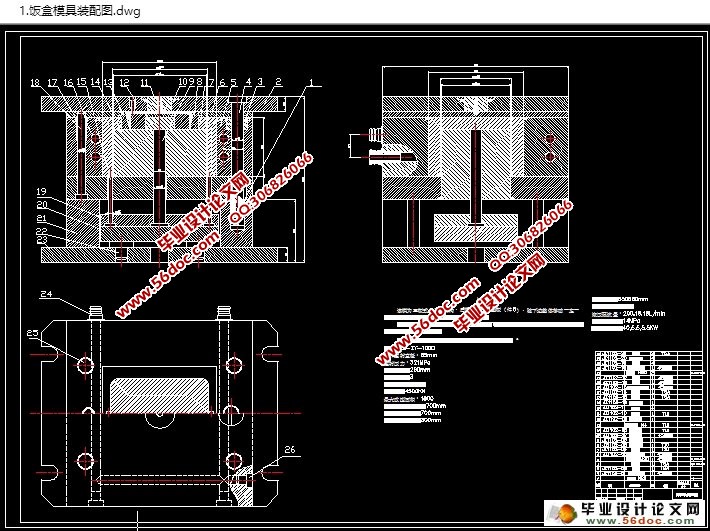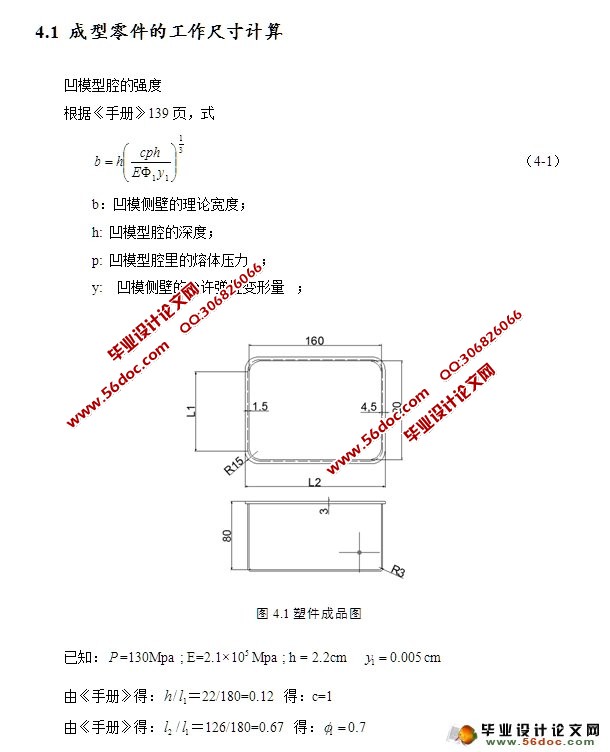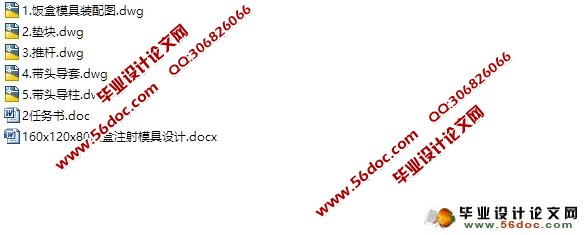方便饭盒注塑模具设计(160×120×80)(含CAD零件装配图)(任务书,设计说明书14000字,CAD图纸5张)
摘要
方便饭盒在我们日常生活里的应用十分常见,在生活中方便饭盒给我们带来了很多方便,我们任何一个家庭中都会用到它。我们在市场中也会看见各式各样的饭盒,不同大小,不同形状,不同材质。这次设计的是日常用品的典型代表,这对我以后的模具设计的知识程度和水平有一定的提升和帮助。此次设计的方便饭盒结构比较简单,我用了CAD软件对产品原件进行了电子绘图设计,通过查阅手头资料对产品的设计进行计算,使方便饭盒的结构更加的合理耐用。在设计时候我们考虑到其应该结实并且耐用,积极查阅手上的资料进行去设计,保证了它在我们生活中的质量。我所设计的方便饭盒是我们最长用的长方体形状。这种设计的特点是结构简单,结实,不容易损坏,清洁起来相当方便。
冷冲模以及塑料模的课程设计是“模具设计与制造专业”的教学计划安排的十分重要的实践环节之一,它是毕业设计的首选内容。模具设计的课程一般安排在学习冷冲模的设计和塑料模具设计之后进行,它的意义在于巩固所学的知识,熟悉相关资料,了解正确的的设计思想,以及掌握设计方式。通过模具设计制造,学会了工艺性的分析、工艺的计算、设计模具的零件结构、在书写技术文件以及查阅文献方面接受到了一次综合性的训练,增加了自己的实践能力。
本次毕业设计的题目是“方便饭盒注射模具设计”,主要是对塑料饭盒设计的思路与加工的过程的介绍。方便饭盒质量比较低、形状十分简单、方便清洁、具有耐腐蚀耐老化、强度比较强、使用寿命长、制作方便、价格便宜等特点,是非常受大家所喜欢的产品,方便饭盒具有很好的发展前景。
本次的方便饭盒设计所主要采用的技术是注射成型,注射成型又称为注塑成型,是现今塑料加工中最常见的方法之一,注射成型的产品约占塑料产品总量的20%-30%,它是成型热塑加工的主要方法。到现在为止除了氟塑料以外,几乎所有的热塑性塑料都可以用注射成型方法去生产塑件。注射成型的最大特点是成型周期短,品种多,制品尺寸精确,产品可以快速更新换代,生产可以自动化、高速化。并且具有极高的经济效益。在设计过程之中,必须先要对方便饭盒的塑件来进行工艺性分析,并且去了解这类型塑件的特性和用途等;再逐一的对模具的基本结构进行分析,根据模具基本的结构来选择的基本模架,接着再核对各种相关的工艺数据,以及根据参考书上的资料以及图书馆中的资料以及公式和一系列表格和参数等。进行对型腔和型芯等零件计算并设计,最后对模具来进行加热和试模等重要环节。
关键词: 模具设计; CAD; 方便饭盒; 注射模
Abstract
Convenient lunch box applications are very common in our daily life, in the life convenient lunch box brought us a lot of convenience, we use it any of a family.We will see in the market a variety of lunch box, different sizes, different shapes, different materials.This design is a typical representative of the daily necessities, the degree of mold design knowledge for my later and level has certain promotion and help.The design of convenient lunch box structure is simpler, I used the CAD software for original products for the electronic drawing design, by looking at data for calculation, the design of the product at hand to make convenient lunch box structure more reasonable and durable.In the design time we should consider its sturdy and durable, actively refer to hand data to design, ensuring the quality of it in our life.I designed by convenient lunch box is our longest with rectangle shape.This design is characterized by simple structure, strong, not easy to damage, clean up is very convenient.
Cold stamping die and plastic mould of the course is designed to "mold design and manufacturing professional" one of the very important practice link of teaching plan, it is the first selection of graduation design content.Die design course of general arrangement in the study of cold stamping die design and plastic mold design, its meaning is to consolidate knowledge, familiar with relevant information, understand the correct design idea, and the way the master design.Through the mold design and manufacturing, learned the art of manufacturability analysis, calculation, structure design of mould parts, technical documents in writing and literature to a comprehensive training, increase their practice ability.
The topic of this graduation design is "convenient" lunch box injection mold design, mainly for plastic lunch box design train of thought and machining process is introduced.Convenient lunch box quality is low, the shape is simple, convenient and clean, with stronger corrosion resistance to ageing, strength, long service life, convenient production, as well as the low price, it is very popular favorite product, has the very good convenient lunch box the development prospect.
The convenience of the lunch box design mainly adopts the technology is injection molding, injection molding, also known as injection molding, is now one of the most common method in plastic processing, injection molding products accounted for about 20% of the total plastic products - 20%, it is the main method of thermoplastic processing forming.So far in addition to the fluorine plastic, nearly all thermoplastics can be used to produce plastic parts injection molding method.Is the biggest characteristic of injection molding molding cycle is short, many varieties, product size precision, can quickly update products, production can be automated, high speed.And has a very high economic benefits.In the design process, must first to convenient lunch box plastic parts for manufacturability analysis, and to understand the characteristics of plastic parts and use this type, etc.;Them one by one of the basic structure of mould is analyzed, according to the basic structure to choose the basic mode of mould frame, then check the relevant process data, and according to the information on the reference books and library data and formulas and a series of tables and parameters, etc.For calculation and design of cavity and core parts, finally the mold to heating and test such as important segment.
Keywords: mold design; CAD; Convenient lunch box; Injection mould
壁厚及制件体积计算
根据《手册》30页,表2-3 取壁厚为:1.5mm
体积:
V1=[180×120 -(80×80-×30)]×1.5
=45 cm³
V2={180×120 -(50×50-π×30)-[180×120 -(44×44-π×22)]}×19
=40 cm³
V=V1+ V2=95 cm³ (3-1)
脱模斜度
选用材料的收缩率比较大,按《手册》29页,表2-1
选择的脱模斜度为:



目 录
第一章绪论 1
1.1 塑料模具的成型特点与发展趋势 1
1.1.1塑料基础知识 1
1.1.2模具 1
1.1.3塑料模具的特点 2
1.1.4塑料模具的发展趋势 2
1.2 注射模设计的要求与程序 3
1.2.1注射成型的原理和特点 3
第二章塑件的工艺分析 5
2.1 材料的工艺分析 5
2.1.1材料分析 5
2.2 塑件尺寸精度分析 6
2.2.1塑件的表面质量分析 7
2.2.2塑件的表面粗糙度分析 7
2.3 塑件的工艺分析 7
2.3.1结构工艺性分析 7
第三章塑料模具设计的内容及步骤 8
3.1 塑件设计 8
3.1.1设计塑件考虑以下因素 8
3.1.2塑件设计的主要内容 8
3.2塑料种类 9
3.2.1通用塑料有五大品种 9
3.2.2常用的工程塑料品种 9
3.2.3常用的热固性塑料品种 10
3.3外观要求 10
3.4 壁厚及制件体积计算 11
3.5 脱模斜度 11
第四章成型的模具设计 12
4.1成型零件的工作尺寸计算 12
4.2型腔的长、宽、深度尺寸计算 13
4.3型芯的长、宽、高度尺寸计算 14
4.4支撑板强度的计算 15
4.5浇注系统设计计算 15
4.6脱模阻力计算 15
第五章注射机的选择 17
5.1最大注射量校核 17
5.2注射压力校核 17
5.3锁模力校核 18
5.4开模行程及顶出型模校核 18
5.5注射机的工艺分析 18
第六章模具材料的选择 20
6.1满足工作条件要求 20
6.2满足工艺性能要求 20
6.3满足经济性要求 21
第七章模具材料的选择 23
结论 24
致谢 25
参考文献 26
|







